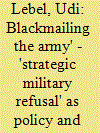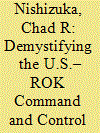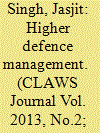| Srl | Item |
| 1 |
ID:
131978


|
|
|
|
|
| Publication |
2014.
|
| Summary/Abstract |
The study shows how 'strategic military refusal' in Israel developed as a rational and institutional means to influence security policies. As opposed to the perspective that sees military refusal as a spontaneous individual act, the study illustrates how organizations operate to distribute military refusal in order to pressure decision-makers to change their military policies. This strategy has proven to be effective when the military is involved with groups that threaten it with refusal - which threatens the military's operational ability and its official and apolitical image. These include soldiers whose civilian authorities, rather than their military commanders, are perceived as an epistemic authority regarding security issues. The case study refers to the impact of strategic military refusal in Israel on security policies and the military doctrine. This was influenced by leftist groups, which, although they belonged to the parliamentary opposition, had dominant presence in the military ranks. Furthermore, the study examines the effect of the use of strategic military refusal on the model of military recruitment.
|
|
|
|
|
|
|
|
|
|
|
|
|
|
|
|
| 2 |
ID:
162445


|
|
|
|
|
| Summary/Abstract |
The “transfer of wartime OPCON” from the United States to the Republic of
Korea, in conjunction with the termination of the obsolete Armistice Agreement,
may provide a unique opportunity for the Alliance to simplify and streamline
its command and control (C2) processes. The C2 structure in South Korea is
complicated by the coexistence of four distinct theater-level commands, the ROK
Joint Chiefs of Staff (JCS), United States Forces Korea (USFK), the Combined
Forces Command (CFC), and the United Nations Command (UNC), all of which
have a unique command structure and set of objectives. As the ROK continues
to grow stronger, both economically and politically, the four commands are
experiencing increasing difficulties synchronizing competing government policies.
The U.S. and ROK governments’ aptitude to address policy differences have a
direct impact on the ability of the four commands to achieve their end-states,
both individually and as a cohesive unit. This paper demonstrates that through the
reorganization of the Combined Forces Command and the elimination of conflicting
responsibilities emanating from the United Nations Command, the U.S.–ROK
Alliance could become more formidable by increasing simplicity, the unity of
command, and the span of control of the current C2 structure.
|
|
|
|
|
|
|
|
|
|
|
|
|
|
|
|
| 3 |
ID:
121138


|
|
|